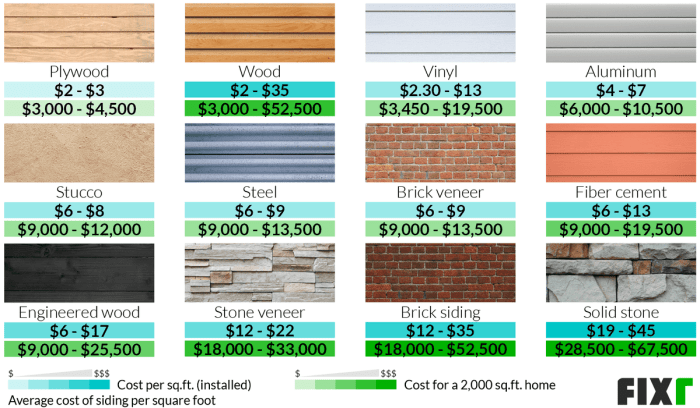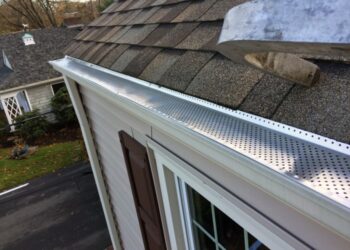Exploring the intricacies of cost for siding installation, this introduction sets the stage for a detailed and informative discussion on factors influencing expenses and ways to reduce costs effectively.
Providing insights into the various types of siding materials, their costs, and additional expenses to consider, this guide aims to equip readers with the knowledge needed to make informed decisions.
Factors Affecting Siding Installation Costs

When it comes to the cost of siding installation, several factors come into play that can influence the overall expenses. Understanding these factors can help homeowners make informed decisions when considering siding options.
Types of Siding Materials
Different types of siding materials come with varying price points. Some common siding materials include:
- Vinyl
- Fiber Cement
- Wood
- Aluminum
- Stone Veneer
Each material has its own unique characteristics and cost implications, affecting the overall installation costs.
Size of the House
The size of the house directly impacts the amount of material needed for siding installation. Larger houses require more materials, resulting in higher costs. Additionally, larger houses may require more labor hours for installation, further contributing to the overall expenses.
Labor Costs
Labor costs play a significant role in determining the overall cost of siding installation. The expertise and experience of the installation crew, as well as the complexity of the project, can influence labor costs. Additionally, location can also affect labor rates, with urban areas typically having higher labor costs compared to rural areas.
Cost Comparison of Popular Siding Materials
When considering siding materials for your home, it’s essential to take into account not only the initial cost but also the long-term durability and maintenance requirements. Let’s compare the costs per square foot for vinyl, wood, fiber cement, and metal siding to help you make an informed decision.
Vinyl Siding
- Cost per square foot: $2 – $7
- Durability: Low maintenance, resistant to rot and insects
- Maintenance: Periodic cleaning with soap and water
Wood Siding
- Cost per square foot: $5 – $10
- Durability: Natural look and feel, needs regular upkeep and painting
- Maintenance: Regular painting or staining, susceptible to rot and pests
Fiber Cement Siding
- Cost per square foot: $5 – $12
- Durability: Resistant to fire, insects, and rot
- Maintenance: Requires painting every 10-15 years, but overall low maintenance
Metal Siding
- Cost per square foot: $7 – $15
- Durability: Very durable, resistant to fire, pests, and rot
- Maintenance: Minimal maintenance required, can last for decades
Each siding material comes with its own set of pros and cons, and the choice you make will depend on your budget and preferences. While vinyl siding may be the most cost-effective option upfront, metal siding could prove to be more cost-effective in the long run due to its durability and minimal maintenance requirements.
Consider the initial investment versus the long-term cost-effectiveness when selecting the right siding material for your home.
Additional Expenses to Consider
When budgeting for siding installation, it’s essential to account for potential additional expenses that may impact the overall cost. Factors such as the removal of old siding, insulation installation, and trim work can all contribute to the final price of the project.
Additionally, the location of the house can also play a significant role in determining siding installation costs. Lastly, obtaining multiple quotes from different contractors is crucial to ensure you are getting the best value for your investment.
Removal of Old Siding
When installing new siding, the removal of old siding is often necessary. This process can incur additional costs due to labor and disposal fees. It’s important to factor in this expense when planning your budget for siding installation.
Insulation Installation
Proper insulation is crucial for energy efficiency and maintaining a comfortable indoor temperature. Installing insulation along with new siding can add to the overall cost of the project. However, the long-term benefits in terms of energy savings and improved comfort make it a worthwhile investment.
Trim Work
Trim work plays a crucial role in the overall aesthetics of your home’s exterior. Whether it’s installing new trim or replacing existing trim, this additional detail can impact the final cost of siding installation. Be sure to discuss trim options with your contractor and include this expense in your budget calculations.
Impact of Location
The location of your house can influence siding installation costs. Factors such as accessibility, local labor rates, and permit requirements can vary depending on where you are located. Rural areas may have different cost considerations compared to urban areas, so it’s important to take these factors into account when budgeting for siding installation.
Obtaining Multiple Quotes
To ensure you are getting a competitive price for your siding installation project, it’s recommended to obtain multiple quotes from different contractors. This allows you to compare pricing, services offered, and overall value. By gathering multiple quotes, you can make an informed decision and select a contractor that meets your budget and project requirements.
Tips for Reducing Siding Installation Costs
When it comes to reducing siding installation costs, there are several strategies you can consider. Whether you are looking to take on a DIY project or hire professionals, there are ways to save money without sacrificing quality.
DIY Siding Installation vs. Hiring Professionals
If you have the skills and experience, opting for a DIY siding installation can significantly reduce labor costs. However, keep in mind that improper installation can lead to costly repairs down the line. Make sure to thoroughly research the installation process and follow manufacturer guidelines to ensure a successful outcome.
Saving Money on Siding Materials
- Consider purchasing materials in bulk or during sales to take advantage of discounts.
- Explore different siding materials to find cost-effective options without compromising quality. For example, vinyl siding is often more affordable than wood or fiber cement.
- Look for recycled or reclaimed siding materials, which can be both eco-friendly and budget-friendly.
- Compare prices from different suppliers to find the best deals on quality materials.
Negotiating with Contractors
- Obtain multiple quotes from different contractors to compare prices and services.
- Ask about any available discounts or promotions that contractors may offer.
- Consider negotiating a lower price by offering to handle certain aspects of the project, such as removing old siding or cleaning up the work area.
- Be clear about your budget and expectations to ensure that you and the contractor are on the same page.
Last Recap
In conclusion, navigating the world of siding installation costs can be overwhelming, but armed with the right information and tips, it is possible to achieve a cost-effective and visually appealing outcome for your home.
Key Questions Answered
What are the most common types of siding materials?
Common types include vinyl, wood, fiber cement, and metal siding.
How does the size of the house affect siding installation costs?
Larger houses typically require more materials and labor, leading to higher installation costs.
Is DIY siding installation a good way to reduce costs?
While it can save money, hiring professionals ensures quality work and avoids potential mistakes.
Why is obtaining multiple quotes from contractors important?
Comparing quotes helps in finding the best deal and ensures transparency in pricing.








